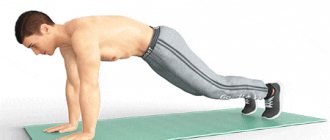Let's talk about cardio again. This is one of the most popular and relevant topics when it comes to losing weight, in which case cardio training should be an integral part of your training program. There are two types of people: some like cardio training, and others absolutely do not, but regardless of whether you consider yourself in the first or second group, if you have set a goal to LOSE WEIGHT, then cardio is the best way to burn fat !
But I’ll tell you a secret: not all cardio workouts can effectively burn fat in the shortest possible time (and that’s exactly what everyone wants: quickly and immediately), and so today I’ll tell you how you need to do cardio correctly in order for the effect of your results. The training was maximum, and the result was visible.
Mechanism of fat burning
To lose weight during exercise, you need to create favorable conditions for the release of fatty acids and their further combustion to release energy. In words, everything looks quite easy and simple, it seems that there’s nothing complicated about it: I came to the gym, worked hard in training, and that’s it – “it’s all in the bag”! You spent a lot of energy, therefore, fat began to be burned. But in reality, everything is not quite the way we would like it to be... Strength training cannot always give us the fat-burning effect that we expect from it. And this is connected precisely with the fat burning mechanism.
In order to lose weight, the body needs oxygen; only in its presence can fats be oxidized.
There are 2 types of energy that our body can use to perform any physical work:
- fast energy (anaerobic and aerobic glycolysis*) - carried out due to the reserves of ATP, creatine phosphate and glycogen.
*Aerobic glycolysis is the breakdown of glucose into carbon dioxide and water. This is fast energy, but it can last for a long time. This method of obtaining energy can only be used by well-trained athletes whose oxidative capacity of their body is at a very high level. This method of obtaining energy is not available to ordinary people.
- slow energy (aerobic lipolysis) - carried out due to the oxidation of fats.
When we start our workout, we first spend ATP reserves creatine phosphate reserves are used (another 10-15 seconds), then glycogen , but without the participation of oxygen (anaerobic glycolysis), and the last source of energy is aerobic lipolysis (burning fat with oxygen).
For reference:
On average, carbohydrate reserves last for 95 minutes of marathon running, while fat reserves last for 119 hours. However, fat utilization requires more oxygen, and when carbohydrate reserves are depleted, the contribution of fat to the energy supply of work increases sharply, and the intensity of the load decreases. In a marathon, this often happens after the 30-kilometer mark—after 90 minutes of running.
Seven remarkable endurance records
- The official International Association of Athletics Federations (IAAF) men's marathon world record is 2:03:59, set by Haile Gebreselasi of Ethiopia on September 28, 2008 during the Berlin Marathon.
- The world marathon record for women belongs to Paula Jane Radcliffe from Great Britain - 2:15:25 (London Marathon, 2003).
- Based on a person's physiological characteristics, the minimum possible marathon time is supposedly 1:57:58. This is equivalent to running a mile in 4:30, which would require a V02max of 84 ml/kg min, a lactate threshold at 85% of V02max, and exceptional running economy (MJ Joyner, 1991).
- The world's longest certified run, the 3,100-mile (4,987.87 km) Self-Transcendence, takes place on a 0.5488-mile (883-meter) course in Queens, New York. Participants run 5649 laps. Only 30 people completed the run, which required an average of running more than two marathons a day for 50 days; cm.:
- The longest cycling race is the Tour d'Afrique, with participants covering 7,500 miles (12,000 kilometers) over 120 days from Cairo, Egypt, to Cape Town, South Africa.
- One of the longest swims was made by Martin Strehl in 2007. The Slovenian swam 5,268 km (80 km over 66 days), crossing the Amazon; cm.:
- Another outstanding swim was the crossing of the Atlantic Ocean in 73 days by Benoit Lecomte, who in 1998 swam 3,700 miles (6,400 km) from Cape Cod (Massachusetts, USA) to France. On average, he swam 6–8 hours a day.
Low to Moderate Intensity Cardio for Fat Burning
The best way to force the body to use fat energy, that is, to use aerobic lipolysis, is low- and moderate-intensity cardio for a long time (50 minutes or more). It is in this mode that the body gradually switches to burning fat, and can do this for quite a long time.
The key point in fat burning is mitochondria (cell organelles), where fat oxidation occurs.
The number of mitochondria in our body determines our ability to burn fat: the more there are, the higher the oxidative capacity of the body, and the more fat can be burned during a workout. The number of mitochondria can be increased through regular aerobic training, to which the body adapts and over time creates more energy stations, thanks to which most of the work can be done through fat oxidation. This is why trained people get rid of their fat component much faster and easier than untrained people: they simply have much more of these same mitochondria responsible for fat burning. So, if you want to always be in shape, exercise regularly and do cardio, thereby increasing the oxidative capacity of your body.
The most optimal heart rate zone for cardio training, the goal of which is burning fat , is 60-80% of the maximum heart rate.
Heart rate (max) = 220-age
Fat burning heart rate (lower limit) = heart rate (max) * 0.60
Fat burning heart rate (upper limit) = heart rate (max) * 0.80
For example, let's take a 30-year-old girl.
Heart rate (max) = 220 – 30 = 190 beats/min
Heart rate (n.g.) = 190*0.60 = 114 beats/min
Heart rate (vg) – 190*0.80 = 152 beats/min
Fat burning heart rate is in the range of 114-152 beats/min. By working in this pulse zone, she will use fat energy evenly and smoothly during her cardio workout.
But the problem is that not all people are ready to spend an hour of their precious time just on cardio training . It is for this reason that this type of cardio for burning fat is suitable in most cases for people who have free time and who like to monotonously run on a track or pedal an exercise bike for an hour, as well as for beginners.
intense cardio is suitable , which takes 2 times less time, but is not inferior in its effectiveness to regular long-term cardio.
Walking is a great substitute for running
The most useful thing is regular walking. Young mothers who spend hours walking with their child are well aware of this method. A steady walk at a moderate pace has the same effect on the body as a low-intensity run. However, here the result will require an hour and a half walk at least every other day. Make sure to keep your breathing even, passing air only through your nose to avoid getting a cold in your throat. And, of course, do not go on such walks in stylish boots with heels or flat soles. Treat your walking as a full-fledged workout, buy suitable shoes - winter sneakers or hiking boots with grooved soles with a small wide heel up to 4 centimeters.
To make the result more obvious, follow your diet. Try not to eat anything one and a half to two hours before training and an hour after, and for dinner, choose light foods containing protein. It’s better to do this right now to be in shape for the New Year and not agonize over how to lose weight by spring.
Interval Cardio for Fat Burning
The processes that occur inside our body during interval cardio are completely different from the processes described above.
I described these processes in more detail in the article Aerobics for weight loss and its pitfalls in the fight against excess weight, if you want, you can read it.
Here I will just briefly remind you.
When we perform high-intensity work with a heart rate above 80% of the maximum heart rate , then a fast type of energy (anaerobic) is included in the work , which is performed without the participation of oxygen. And since oxygen does not take part in energy production, it means that fats are not oxidized, so it turns out. That's right. At the moment when the body uses creatine phosphate and glycogen to perform physical work, fat oxidation does not occur, but this phase lasts from 10 to 130 seconds, no more.
Further, when the body has exhausted fast sources of energy, and while they are being restored, it is forced to switch to alternative energy sources, namely aerobic lipolysis with the participation of oxygen. This phase coincides with a decrease in the pace of cardio and our heart rate, and at this time we have a good opportunity to burn fat as a source of energy.
Then when we increase the pace of our cardio again, we switch back to fast energy sources (creatine phosphate, ATP and glucose) and this continues in a circle the entire time we are doing our interval cardio.
It turns out that in 15-20 minutes we burn fat, but this does not happen constantly, as with moderate-intensity cardio, but in periods: the process of aerobic lipolysis alternates with the process of anaerobic glycolysis and the breakdown of creatine phosphate. This alternation, associated with changing speeds and tempo of work, is a very strong stress for the body, which disrupts its homeostasis, and within a few hours after training it recovers, spending quite a lot of calories on this energy-intensive process, and you burn fat even if you just sit on a chair and don't move.
Also, during interval cardio, the level of L-carnitine in the body increases, which is responsible for transporting fatty acids to the mitochondria of muscle cells, where they are burned; and there is also a large release of somatotropic hormone into the blood, which is directly related to the process of fat burning and acceleration of metabolism.
This is why interval cardio is considered more effective for burning fat than regular cardio at a gentle pace. It’s just that after such a high-intensity cardio workout, you will burn calories and burn fat for a very long time, from several hours to a whole day!
Low Intensity Interval Training: Difference to HIIT
As you already understood, in general, NIIT is easier: the load intervals take place at a lower heart rate, and the recovery interval between them is longer. As a rule, the active stage is 90 seconds, the easy stage is 3-5 minutes, but, of course, everything is individual. “For example, I’ll give you low-intensity interval cardio training,” explains Ilya Frank. — This is alternating running with functional exercises. The essence of this workout is not to go into the zone of anaerobic glycolysis, that is, the intensity should correspond to 50-80% of the maximum heart rate throughout the entire workout.” In other words, the active interval is no more than 80% of the maximum heart rate (remember, this is 220 minus age). That is, this is not a sprint to the limit, as in HIIT, but just running. The recovery interval is about 50% of your maximum heart rate, that is, light exercise with your own weight or walking. In a similar HIIT interval, you would either jog or rest very briefly.
Cons of Interval Cardio
But it would be wrong to advise doing such cardio to absolutely everyone who decides to lose weight. There are a number of contraindications and precautions associated with interval cardio.
- Not for beginners. If you have just started getting into fitness and do not have much experience, then I would not advise you to immediately use interval cardio in your training. You must first master the correct running technique (jumping, cycling, etc.), get used to the load, prepare your body, undergo a medical examination and find out if you have problems with the heart, blood pressure, joints, and only then slowly move on to this kind of training.
- It needs to be properly combined with strength training . Doing interval cardio after strength training your legs will put too much stress on your knee joints, ligaments and tendons, thereby doing more harm than good. It is better to do interval cardio training either on a separate day or after training the upper body, but not the legs and buttocks. This is very dangerous!
- It is not recommended to do it too often. There is no need to go to extremes and do interval cardio every day, or even 2 times a day (there are such cases). Nevertheless, intense cardio puts a lot of stress on the heart, joints, and also does not have the best effect on the nervous system, which is why one or two times a week will be quite enough to make the most of the benefits of this type of training and not overwhelm you. your body into a state of overtraining.
But if you take into account all these points and correctly approach training at an interval pace, then you will only benefit from them in the form of saving your time and lost pounds.
Well, now let's look at several options for interval cardio training for burning fat.
And we will consider the first option for effective cardio training using the example of interval running, which is ideal for those who go to the gym or have a treadmill at home.
Time for yoga
Most runners choose this type of physical activity because they are introverts by nature and are not ready to go to the gym. Therefore, we will not consider the option of going out into public; we will manage it ourselves at home. If you've never done yoga, now is the time to start. In terms of its type, this load is as similar as possible to smooth running, but it also has a bunch of advantages - it stretches and takes care of the joints and spine.
The most useful thing is regular walking. Young mothers who spend hours walking with their child are well aware of this method.
But be careful: if you are introduced to yoga for the first time, do not chase high results and do not try to squeeze the maximum out of your body, as this can cause harm. Give your body time before you start demanding anything from it - at least three months. Until then, work in light mode. There are many online courses on yoga, but I recommend that you first overcome your introverted nature and go to two or three classes with a specialist who will teach you how to breathe correctly and tell you about dangerous mistakes.
Cardio workout for burning fat “Interval running”
ATTENTION!
The types of cardio given below are suitable for already trained people who have experience working out in the gym or at home, but they are not suitable for beginners!
Option #1
1 minute – run 11 km/h
1 minute – sprint (running at your maximum speed), this could be 13 km/h, or maybe 15 km/h.
1 minute – walking 6 km/h
And we repeat everything from the beginning.
Cardio workout time: 30 minutes with warm-up and cool-down
Option No. 2
30 seconds – 10 km/h
30 seconds – sprint 13-14 km/h
So we run for 10 minutes
2 minutes – walking 6 km/h
And again we repeat the 10-minute run.
Cardio workout time: 30 minutes with warm-up and cool-down
Option #3
3 minutes – run 11 km/h
3 minutes – run uphill (3%) 10 km/h
1 minute – sprint 13-14 km/h
1 minute – walking 6 km/h
Repeat 2 more times.
Cardio workout time: 30 minutes with warm-up and cool-down
Option No. 4
2 minutes – run 11 km/h
1 minute – running on the right side 7 km/h
1 minute – running on the left side 7 km/h
1 minute – walking 6 km/h
Repeat 4 more times.
Cardio workout time: 30 minutes with warm-up and cool-down
these types of cardio workouts either after your upper body strength training, or on a separate cardio day, no more than 2 times a week. The advantage of interval running, as opposed to jogging, is the fact that you can do it on a separate day from your workout, and at the same time run not for 60 minutes, as expected, but for only 30 minutes.
- Interval training is the number 1 enemy of fat!
Four endurance programs
The endurance exercise programs below are based on scientific research reviewed by La Forgia, Withers & Gore (2006). An adequate warm-up (about 10 minutes of light exercise) and cool-down (5-10 minutes of low-intensity exercise) should be performed for each program. All of the following training methods can be performed to develop aerobic capacity.
- Exercises at the lactate threshold level
Exercises at the lactate threshold level are performed with the highest load that the practitioner can maintain in the allotted period of time (20-50 minutes). The client works with the maximum load, which he can perform continuously for 20 to 50 minutes. - Alternating between types of aerobic endurance exercise
The client alternates between types of aerobic exercise (eg, treadmill and elliptical) every 20 to 40 minutes, maintaining intensity at ≥ 70% of HRmax. The time spent on each type does not change. The number of alternations depends on the client’s level of training. - “Stepped” endurance exercises
The client increases, decreases, or increases and then decreases the intensity of the exercise every 10 minutes. For example, starting from ≥ 50% HRmax goes to ≥ 70% HRmax (or vice versa). In total, from 3 to 5 “steps” are performed. - Mixed-paced endurance exercises
A pre-selected type of exercise is performed randomly changing the duration (5-, 10- or 15-minute blocks) and intensity of the load. For example, a treadmill session starts with 10 minutes at 50% HRmax, then 5 minutes at 70% HRmax, then 15 minutes at 60% HRmax, then 10 minutes at 75% HRmax, and finally 5 minutes at 50% HRmax.
Effective cardio for burning fat at home “Jump rope”
If you're working out at home and don't have a treadmill, don't despair! This fact should by no means put an end to your dream of losing weight! Cardio for burning fat at home is in no way inferior to the previous option. One of the best ways to make the most of your cardio workout is to buy a jump rope and learn how to jump on it.
I have already filmed and written more than once about the benefits of jumping rope and its super properties for burning fat. I won’t repeat myself, I’ll just leave links below where you can study this topic in more detail.
- How to jump rope correctly to lose weight?
- Jump rope for weight loss. Fitness at home
And now I will give you two more options for cardio training for burning fat using a jump rope.
Interval cardio on a jump rope for beginners*
- Overlapping jumps – 5 minutes. Tempo: medium
- Scissor jumps – 1 minute. Pace: fast
- Overlapping jumps – 1 minute. Tempo: medium
- Jumping with high knees - 1 minute. Pace: fast
We repeat the entire circle of 3 exercises from the beginning. In total, you need to do 4 laps (32 minutes) during the workout. We finish the cardio workout by jumping at a calm pace (cool-down).
*For beginners - can be performed if there is no obesity, problems with joints, spine, heart, blood pressure and other health-related contraindications.
Interval cardio on a jump rope for advanced
Option #1
- Classic jumping on two legs – 3 minutes. Tempo: medium
- Jumping with high knees - 1 minute. Pace: very fast
- Jumping with legs thrown forward – 2 minutes. Tempo: medium
- Jumping with high knees - 2 minutes. Pace: very fast
- Jumping with legs thrown forward – 1 minute. Tempo: medium
- Repeat point 2
- Repeat point 3
- Repeat point 4
- Repeat point 5
- Etc.
The workout should take 30-35 minutes in total. We finish our cardio workout with classic jumping jacks at a relaxed pace.
Option No. 2
***
These were the main points that I wanted to convey to you when talking about cardio training for burning fat. I hope this article was useful to you and you learned something new and interesting for you. The next time you decide to do cardio, choose the option that primarily appeals to you. The main thing in the training process is to enjoy it, as they say: “You can’t be nice by force,” - this statement is also true for training. Cardio training for fat loss should be suitable for you: you like to do long and low-intensity cardio - please do it for your health! If you prefer something short but intense, that’s your right! Only you can decide what suits you and what doesn't! Any option you choose will be effective, provided that you know the features of a particular type of cardio and adhere to specific recommended rules regarding the implementation of the chosen cardio workout.
Sincerely yours, Janelia Skripnik!
Final verdict: The winner of the battle of the aerobics titans is...
The primary goals of most endurance exercise programs are to improve cardiovascular, metabolic, and musculoskeletal function of the body. Over the years, long-term aerobic exercise has been the method of choice to achieve these goals. However, research has shown that HIIT produces similar and in some cases greater improvements in physiological parameters in less time. Incorporating HIIT (at appropriate intensity and frequency) into your clients' cardiovascular training provides you with a time-effective way to achieve their goals.
Since both HIIT and NIPT programs improve the physiological and metabolic functions of the human body, a balanced inclusion of these methods in clients' training programs is a win-win path to improved cardiovascular and overall performance. Use HIIT and go for endurance!
How does cardio exercise affect the body?
When it comes to a person’s interaction with cardio exercise, everything is very, very individual. It is worth considering that this type of training has its own subtypes: low-intensity and high-intensity cardio. They are distinguished by the heart rate at the time the movement is performed. High-intensity aerobic exercise often causes an increase in appetite. Therefore, giving them up will most likely lead to a reduction in calories consumed. Cardio can also help improve sleep. But daily activity may decrease if you overdo it with training.
Photo: istockphoto.com










